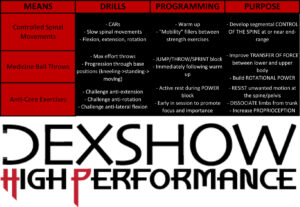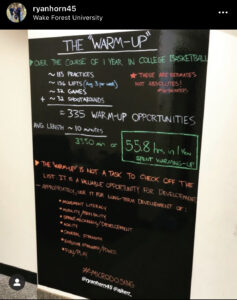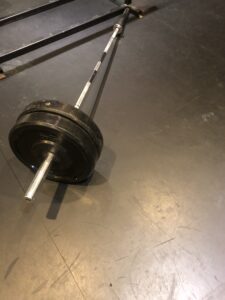Here it is: the Holy Grail for long term, sustainable upper body training. Just kidding, but seriously, follow these guidelines to keep your upper body strong and your shoulders feeling great.
HEALTHY SHOULDER PULL : PUSH RATIOS
PULL
- 2:1 Pull to Push Ratio Weekly
- 2:1 Horizontal to Vertical Pull
- Allow Shoulder Rotation More, Fixed Grip Less
- Vary the Pulling Angle
- Know How to Achieve Shoulder Stability when Pulling
- Only Pain-Free Variations
PUSH
- At Least 1:1 Free-Scap to Fixed-Scap Pushing
- Use Neutral Grip More Often with Fixed-Scap Variations
- Minimum Effective Dose of Overhead Pushing
- Vary the Pushing Angle
- Know How to Achieve Shoulder Stability when Pushing
- Only Pain-Free Variations
STRENGTH STANDARD = 1RM CHIN UP (BODYWEIGHT + LOAD) = 1RM BARBELL BENCH PRESS
Shoulder pain – who needs it? Modern life has athletes and adults alike spending more time sitting and staring at screens than ever, whether it be on the computer, playing video games, or staring at our phones. The consequence? Quarantine Posture (Link HERE with a few exercises to combate it). Weak, untrained upper back musculature, forward head and shoulder position, and a posture that puts the Hunchback of Notre Dame to shame. Besides diminishing your physical appearance, it’s a recipe for cranky, pinchy shoulders that don’t function well in the gym, your sport, or real life.
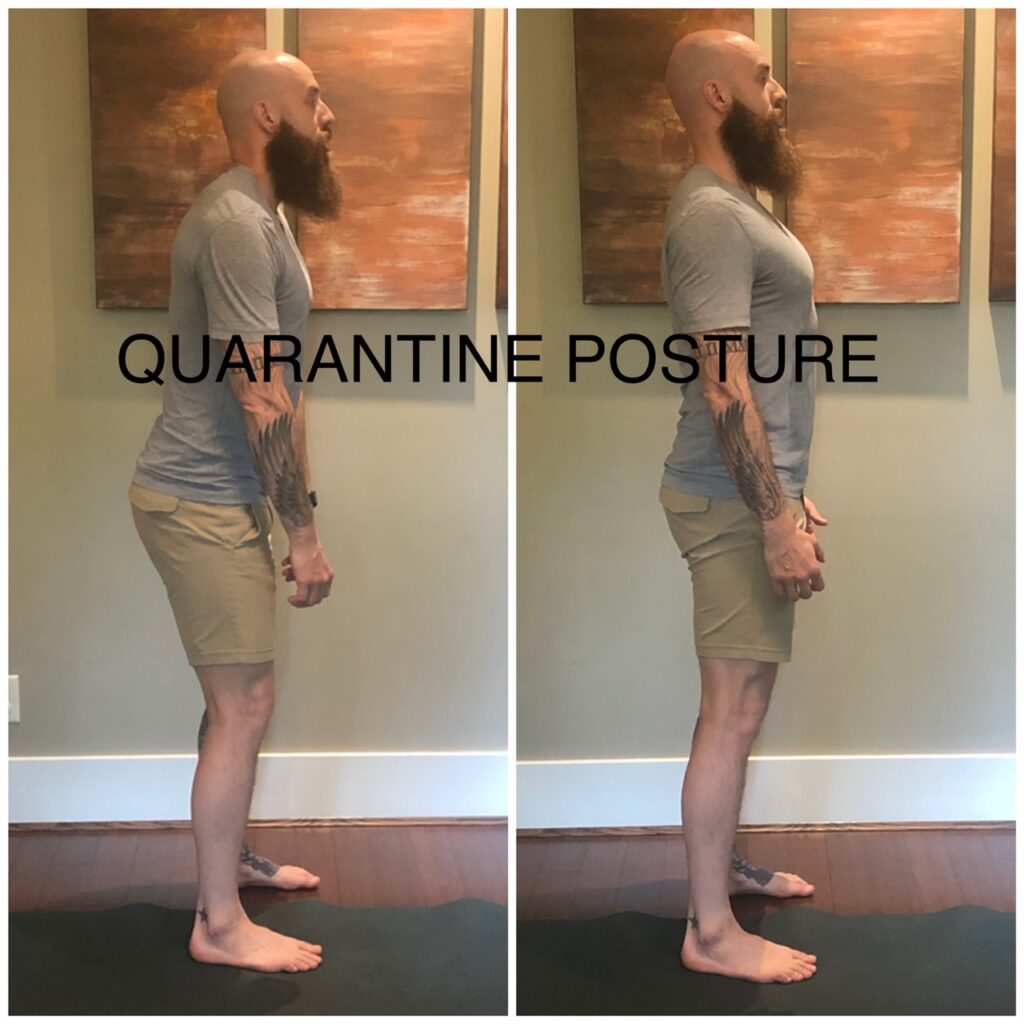
If you have chronic shoulder pain and limited shoulder range of motion, here’s a newsflash: YOU PROBABLY DO NOT DO ENOUGH PULLING EXERCISES. Yes, I’m talking to you, guy who does 100 push ups a day but can’t put his hand up in class. Yes, I’m talking to you, lady who jerks 200lbs but can’t do a chin up. Yes, I’m talking to you, hockey player who claims sport-specificity. And, yes, I’m talking to you, granny who has trouble reaching out to give your grandkids a hug. I’ve found over the years that those who suffer from shoulder pain and discomfort have some things in common. They UNDERPERFORM PULLING VARIATIONS, PERFORM THEM WITH POOR FORM AND INCOMPLETE RANGE OF MOTION, USE TOO MUCH LOAD (OVERESTIMATE STRENGTH), AND PRESS TOO MUCH, TOO OFTEN, AND WITH POOR MECHANICS. Don’t think it’s you? Can you perform a strict chin up (bodyweight + added load) that is equal to your barbell bench press 1 rep max? This ratio exemplifies the balance of your upper body pulling and pushing musculature. Working intelligently to hit this metric can be a game changer in terms of shoulder health, overall physical appearance, and sustainability of training.
Pulling exercises are key to shoulder health and performance. Pulling variations primarily stress the upper back muscular, shoulder extensors, and elbow flexors. If you’re into muscle names, we are looking at developing the latissimus dorsi, mid/lower trapezius, rhomboids, “rotator cuff,” posterior deltoid, and biceps group. “Rotator cuff” is in quotations since many people think it’s one muscle BUT IT ACTUALLY CONSISTS OF 4 MUSCLES: supraspinatus, infraspinatus, teres minor, and subscapularis. The shoulder is complicated joint with a high potential for mobility as it is a ball (head of the humerus) and socket (glenoid fossa of the scapula). Some of the above muscles act on the humerus (upper arm bone), some of them act on the scapula (shoulder blade), and the “cuff” originates at the scapula and inserts on the humerus. OK, enough with the boring anatomy talk – why do my shoulders hurt?
Assessment
Do you have healthy shoulders? Here are two self-tests you can perform to see if you currently have a “normal” shoulder joint. I’ll classify “normal” as adequate range of motion and pain-free for the purpose of this article.
1. Shoulder Impingement Test: This test can determine if you are dealing with an impinged shoulder currently.
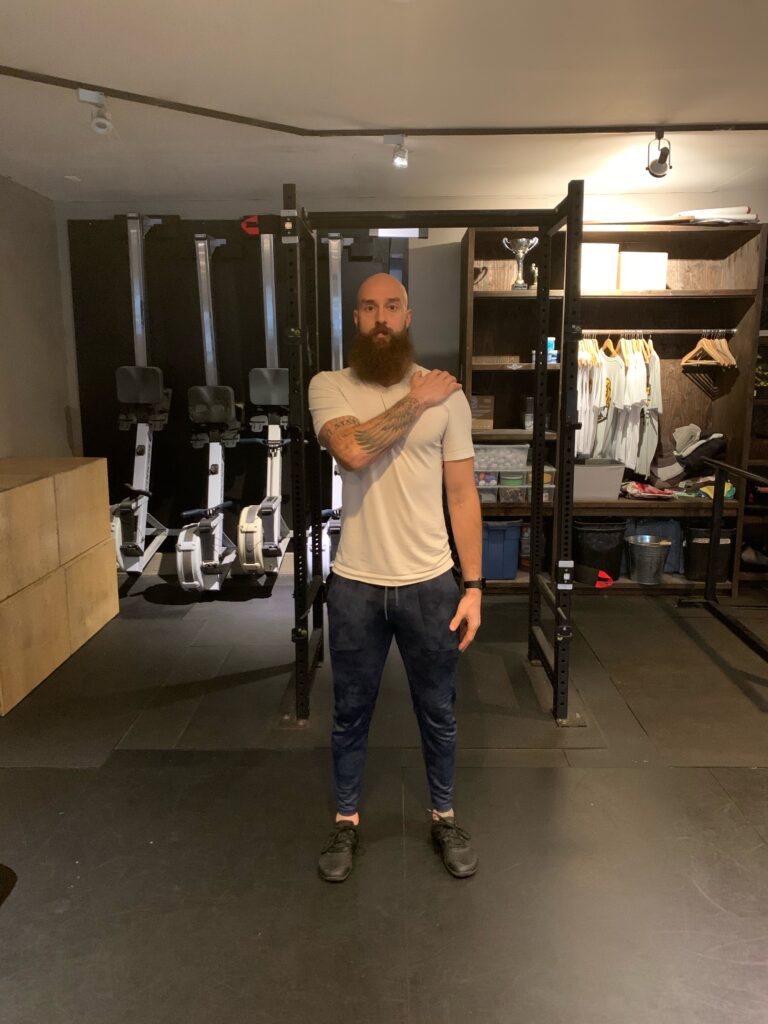
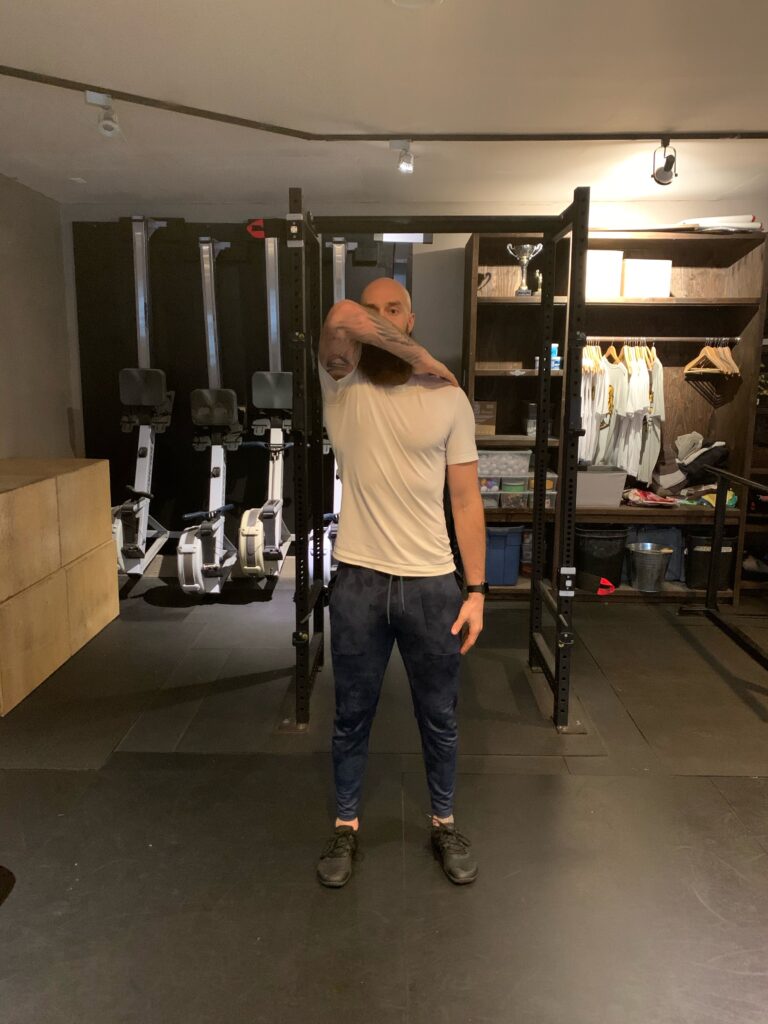
Reach one hand across your body to the opposite shoulder and hold on, palm down. Next, raise that elbow as high as you can like you’re trying to smell your own armpit. Do you feel any PAIN OR DISCOMFORT in your shoulder? Repeat on the other side. This is a PASS/FAIL test. It’s a yes or no. If you feel ANY pain or discomfort, you have an ACTIVE SHOUDLER IMPINGEMENT, and should not be performing overhead exercises… FOR NOW. Don’t feel anything? Great, you’re clear to go overhead.
2. Functional Movement Screen Shoulder Mobility Screen: This screen provides insight into the gross shoulder and thoracic spine mobility and motor control.
Stand tall and stack your ribs over your pelvis like you are doing a standing front plank. Maintaining this spinal position, reach your arms out in front of you and grab your thumbs in a fist. From there and keeping the fists, reach one hand behind you by internally rotating the shoulder, and one overhead trying to get your fists as close to each other as possible. It needs to be performed in one smooth motion. DON’T NOT FLARE THE RIBS AND ARCH YOUR BACK – this is a shoulder mobility test. Make sure to test both directions for each side. There are 4 possible outcomes:
0 - PAIN
If the action of the screen causes you pain, you have work to do. Stop performing pushing exercises and focus on pain-free pulling variations and shoulder mobility work.
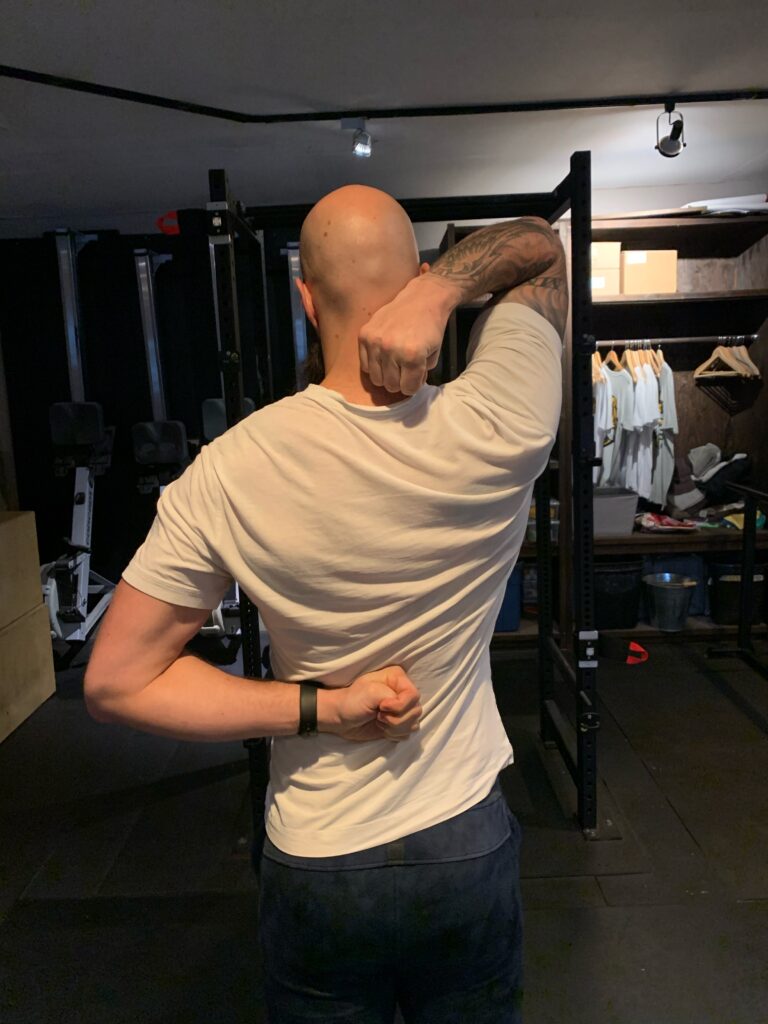
1- INADEQUATE SHOULDER RANGE OF MOTION
Fists are greater than 1.5 hand lengths (base of palm to tip of middle finger) apart. You do not have fundamental motion of the shoulder joint. Continue to train with pain-free exercise variations but put in extra work for your shoulder mobility.
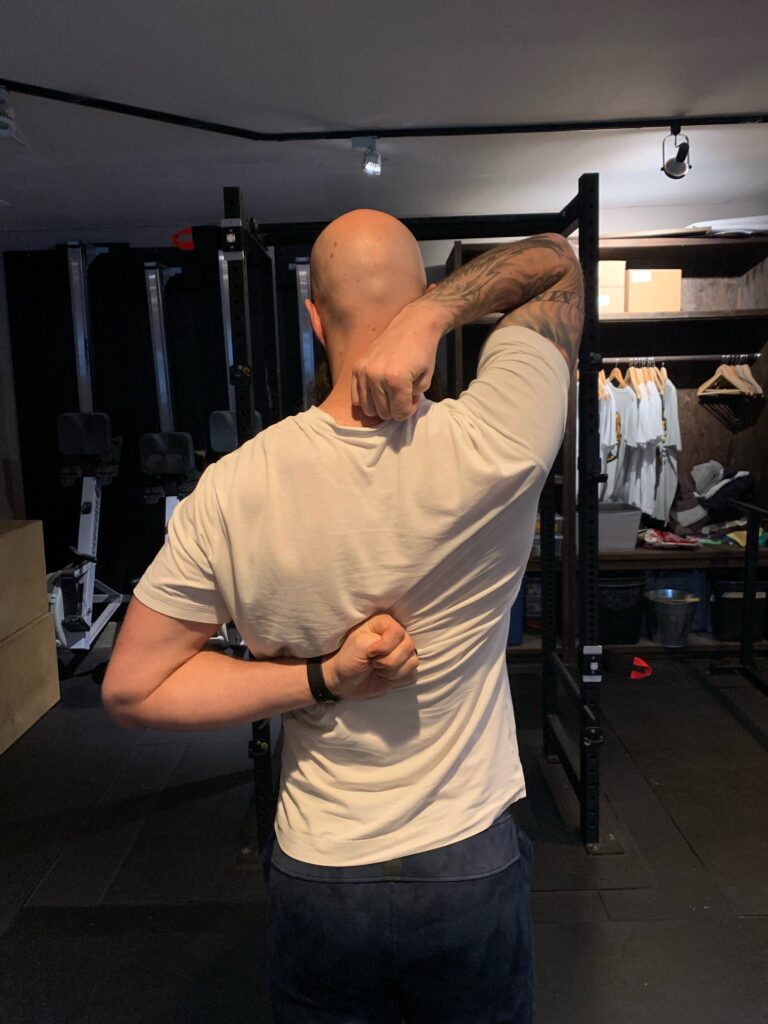
2 - ADEQUATE SHOULDER RANGE OF MOTION
Fists are between 1.5 and 1 hand lengths apart. Your shoulder range of motion is adequate for most sporting and real-life activities. Unless you have a specialized task that requires greater ROM – gymnast, baseball pitcher, contortionist, or something like that – you need to maintain what you have and continue to strengthen the full capacity of your shoulder through a solid, pain-free training program (for ratios and exercise examples, read on).
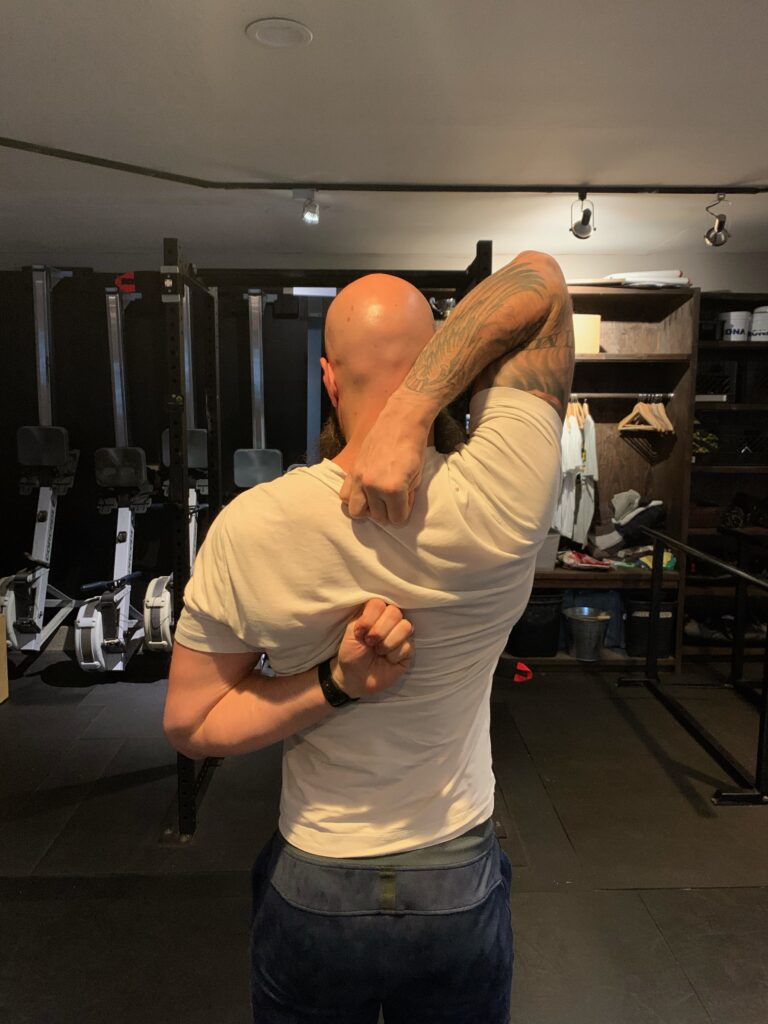
3 - HIGH DEGREE SHOULDER RANGE OF MOTION
Fists are less than 1 hand length apart. You possess great shoulder joint range of motion. Take control of this. You must train full ROM and develop the musculature to support your phenomenal shoulder joint. Pull a lot, push too, train at different joint angles – the world is your oyster!
NOTE: I’ve assessed individuals who FAIL the impingement test but score a 3 on the FMS Shoulder Mobility Screen. These people NEED SHOULDER STABILITY TRAINING. Some kettlebell work and some coaching on how to centrate the joint during movement made the impingement GO AWAY.
So now you know where your shoulders stand. THE GOOD NEWS IS THAT WHAT YOU DO AND HOW YOU TRAIN CAN CONTROL WHAT HAPPENS NEXT. It would have been easy to blindly just list some pull:push ratios at the top of the page and for you to just take my word for them, but that wouldn’t have helped the problem. We need to understand why we chose to do things, right? Here are THREE general rules for UPPER BODY TRAINING for healthy, pain-free shoulders:
RULE # 1: IT SHOULDN'T HURT
This goes for all types of strength training, conditioning, working out, exercising, doing cardio. Ask yourself: “Does it hurt?” If the answer is yes, modify or lateralize the exercise so it is pain-free. Seems silly but it bears repeating: IF IT HURTS, DO SOMETHING ELSE. No, it doesn’t need time to warm up, or “it only hurts a bit,” – your body is telling you something, listen. If someone tells you your pain will get better the more you do it, run! Training through pain is a recipe for disaster, and it’s only a matter of time. This doesn’t mean you can never do what is causing you pain right now, but rather your body isn’t physically prepared to do the movement, load, or volume AT THIS TIME.
RULE # 2: PULL TWICE AS OFTEN AS YOU PUSH
I mean this literally, on a weekly scale. For every set of PUSHING exercises you complete during your weekly training sessions, do twice the amount of PULLING exercises. It’s dependent on how frequently I see a client, but the way I keep this in my programming templates is often two pulls and one push per sessions for full-body training splits and/or extra pulling on lower body days for more frequent trainees. Legendary strength coaches like Joe DeFranco are proponents of the 2 PULL:1 PUSH ratio for shoulder health. What’s more? For the meatheads out there, “overtraining” your back by pulling more can help boost the big pushing exercises like bench press, military press, etc. by allowing you to stabilize your shoulder joint better, creating a better platform to express your true pushing strength.
RULE # 3: HORIZONTAL PULLS TWICE AS OFTEN AS VERTICAL PULLS
This is a big one from Dr. John Rusin who created the Pain-Free Performance Specialist Certification and it makes tremendous sense. For every VERTICAL pulling variation you perform weekly, you should perform twice the amount of HORIZONTAL pulling. Generally, the overhead position causes problems for a lot of people initially, so get strong pulling straight ahead and armour your shoulders in normal ranges more than going overhead. To me, horizontal pulling variations are the most neglected exercises across training programs. It seems like many write them off as being too easy or not advanced enough when, in reality, a healthy dose of TRX rows, DB rows, and cable rows can make A WORLD OF DIFFERENCE when it comes to shoulder function and performance…when performed correctly.
With those in mind, let’s talk about UPPER BODY PULLING.
The first big thing that is of paramount importance during pull variations is that the shoulder joint is stabilized – that means that the humeral head should be centrated on the glenoid. In English: the ball needs to be on the right place of the socket. Sounds simple enough, but in the case of the shoulder joint, the ball is much bigger than the actual socket. Moving the shoulder joint recklessly through a range of motion, under load, without a good ball and socket relationship can be the primary driver of shoulder pain. If you don’t know how to pack your shoulder (stabilize it), here are some good kettlebell exercises that help to build static stability in the joint:
With these variations, the back and “rotator cuff” musculature need to work synergistically to hold the humeral head in the glenoid (keep the ball in the socket). For shoulder stability work, I prefer using kettlebells as the loading implement due to their offset nature – the centre of mass of the bell is not centred around the handle like it is with dumbells or barbells. This forces the cuff to reflexively work harder to stabilize the shoulder. Once you’ve mastered this position/feeling, you can move on to performing dynamic pulling exercises.
Generally speaking, I like to categorize pulling exercises as HORIZONTAL PULLS or VERTICAL PULLS but before we get into those, here are some important things to consider about the shoulders and scapulae when pulling:
- The majority of untrained or poorly trained individuals will present with a forward head and shoulder position. The scapulae (shoulder blades) are protracted (spread), depressed literally and figuratively, and anteriorly tipped (winged). This all makes it very difficult to put the shoulder joint in a good position to function well and nearly impossible to get the arms fully overhead. A chronically rounded upper back or thoracic spine doesn’t help either.
- Pulling variations need to focus on retracting the scapulae – squeezing them together – while maintaining a centrated shoulder. For vertical pulling, we need the serratus anterior to upwardly rotate the scapulae to provide a better shoulder position when working overhead.
- Shoulder joints were designed to rotate. Implement exercises that allow your shoulder to rotate as it moves or choose fixed grip implements that give you cranky shoulders a chance to function. External rotation of the shoulder is when your thumb rotates towards the outside of your body, internal rotation is what you do when the cops made you dump out your hard cider at a house party when you were underage. External rotation is usually a more stable shoulder position so leverage this with your choices when performing fixed grip exercises, especially if you have pinchy shoulders – use UNDERHAND GRIP INSTEAD OF OVERHAND GRIP for chin/pull ups, barbell bent over rows, etc.
- Give your shoulder some love – SMR and stretch your internal rotators, strengthen your external rotators. Direct shoulder external rotation work, when performed well, can do wonders for clearing up shoulder pain or act as great “prehab” to keep your shoulders healthy, pain-free, and moving freely.
HORIZONTAL PULLING
Horizontal pulling is just what it sounds like – pulling against resistance that is oriented perpendicular to your torso. These exercise variations should make up the bulk of your multi-joint, upper body training. You’ll notice that for the most part, this is basic stuff – continually mastering the basics is essential for long term, sustainable strength training. I love using the TRX for horizontal pulling variations – it allows free shoulder and scapular movement, including rotation, and the resistance can be manipulated in an instant. Every person I’ve ever trained has the TRX Row in their first program to reinforce proper pulling technique.
The TRX W Row adds more of an external rotation focus to the pull. Make sure to keep tension on the straps throughout the full range of motion, especially at the top where we’re the weakest.
Here is a single-joint (movement comes only at the shoulder joint) TRX variation that works the deltoids and upper back:
Cable columns are a great way to train pulling. To save space, I have a Dual AnCore Trainer set up that mounts onto the rack to simulate a cable machine. Like the TRX, cable exercises with a handle make it easy to rotate the shoulder throughout the movement.
It’s important to vary the angles we pull from to expose the body and shoulder to multiple stabilization strategies that help to bulletproof our movement capabilities. Below are a Cable Half Kneeling Single Arm High to Low Row and a Cable Rope Facepull variation. Facepulls can be an excellent choice when it comes developing undertrained upper back musculature. Make sure your form is strict and you use an appropriate load so you feel them in your upper/mid back. Pretty much any cable exercise can be replicated by resistance bands or tubes to a degree if you don’t have access to a cable column or AnCore system.
Kettlebells are also a great tool to use for pulling exercises since the bell hangs below the grip and allows for freely rotating shoulders. You’ll notice below that my shoulder rotates externally on each row, ending in a neutral position at the top. This variation also challenges the hip hinge position and provides a novel anti-rotation stimulus to the core.
Remember when I said we need to consistently master the basics? Well, here is one of the most basic upper body pulls in the book – the DB 3-Point Single Arm Row. You should be pulling the dumbbell on an angle back towards your hip and not just lifting it straight up, as well as thinking about squeezing your lat by driving your elbow to your back pocket.
Lastly, here is one fixed grip horizontal pull. By fixed grip, I mean that your shoulders cannot rotate freely throughout the range of motion. By using a supinated (underhand) grip we set the shoulders in a more externally rotated position which tends to leave us stronger and feeling more stable.
VERTICAL PULLING
Vertical pulling exercise variations can make up some of your pulling variations but you should always make horizontal pulls the priority. Say I do 12 working sets of horizontal pulls over the course of a week, I probably only need to perform 6 sets or less of vertical pulls – ESPECIALLY IF YOU HAVE CRANKY SHOULDERS. Starting with my favourite vertical pull, we are back on the cable column for the Cable Tall Kneeling X-Pulldown:
Every single person that I’ve had do this exercise say they love it. It feels natural and is as shoulder-friendly as vertical pulls come. Shoulders tend to do well with this cross body internal rotation to external rotation diagonal pattern. This variation also helps groove shoulder rotation through the pulling motion and allows free moving scapulae.
Another cable variation I use fairly often if someone is working towards a pull up is the Cable Half Kneeling W-Pulldown:
What’s the difference between these next two exercises?
Both are fixed grip, vertical pulls but check out the hand position. In a Chin Up, we use a supinated grip (palms facing you) to wind the shoulder up into a more externally rotated position. This typically frees up more space in the joint to lower risk of impingement and/or pain and provides a more stable base for the upper body to work. A Pull Up, on the other hand, uses a pronated grip (palms facing away from you) which can exacerbate pre-existing shoulder pain or stress some of the structures supporting the joint. Pull Ups are not a bad exercise at all, but they can be for some people. My years training out of a CrossFit gym have led me to see a whole lot of shoulder rubbing and overhear a lot the age-old “my shoulders hurt so I’ll just use light weights” comments. Following the ratios and making simple grip adjustments can make for much happier shoulders – you’re welcome.
PUSHING EXERCISE VARIATIONS
I’d be remiss not to mention pushing exercises if we’re talking about a pull:push ratio. We can also categorize pushing variations as horizontal (pushing in front of you) and vertical (pushing overhead). Similar to pulling, horizontal pushing exercises are generally LESS stressful to the shoulder joint, while horizontal variations are MORE. Futhermore, we need to consider whether a pushing movement is FREE-SCAP or FIXED-SCAP:
FREE-SCAP PUSHING
- The scapulae can move freely, specifically through protraction and/or upward rotation, which can typically be “easier” on the shoulder joint
- The shoulder blades move during each rep, as well as the shoulder and elbow joints
- The most common example of a free-scap push is a standard Push Up
FIXED-SCAP PUSHING
- The scapulae need to be fully depressed and retracted to provide a stable base for the shoulder joint
- The shoulder blades, once set in position, do not move throughout each rep as the shoulder and elbow joints perform the exercise
- The most commonly used fixed-scap push is probably the Barbell Bench Press
At the very least, I like to use a 1:1 RATIO OF FREE-SCAP:FIXED-SCAP PUSHING. Depending on someone’s assessment and shoulder history, I might only use free-scap pushing variations, or NO PUSHING AT ALL if their shoulders are really banged up. Most often, progressing a lot of solid pulling exercises and adding shoulder awareness and upper back strength allows a transition to some pushing in several weeks. Let’s get into some examples.
HORIZONTAL PUSHING
Starting with a basic free-scap exercise like a Push Up is a good idea. A lot of people think they are above push ups and try to use excessive volume when they really can’t perform 1 solid rep with good shoulder and trunk position. Having trouble with the Push Up? Full article on how to fix it and progress it appropriately HERE.
Once you’ve mastered the original, experiment with push up variations – there are 100s of choices. Here is an advanced variation:
Using a cable column is another good option when it comes to free-scap horizontal pressing – it adds an element of core stability (anti-extension) and can be performed standing which makes it “more functional” for sports and life. Cable variations can also be done unilaterally (single arm) to introduce some anti-rotation into the mix.
Below are two fixed-scap pushing variations – the Barbell Bench Press and the Dumbbell Neutral Grip Bench Press:
The Barbell Bench Press is a fixed-grip, fixed-scap push that puts the shoulder into a more internally rotated position and causes a lot of problems at the shoulder for many people. Benching heavy is cool but not when you’re physically unprepared and cannot put your scap and shoulder in the right position. A switch to the dumbbell variation with a neutral grip might just be the answer you’re looking for. Too simple?
In between horizontal and vertical pushing is sort of a HYBRID MOVEMENT. Many people who feel pain or discomfort while pressing overhead tend to do fine with this middle ground as it’s less demanding on the shoulder joint and can be biased towards free-scap movements. Push up variations like the Yoga Push Up allow for a semi-overhead push with scapular upward rotation:
A Landmine set up (full blog on Unconventional Landmine Variations to Blow Up Your Program HERE) is also a great way to get some upward rotation of the scapulae and save your shoulders. The Landmine Half Kneeling Single Arm Press is a good place to start:
Adding a forward lean during the press can almost simulate the overhead position without the shoulder stress. Most folks who struggle with pain in overhead work tend to be find here:
Something like a DB Incline Bench Press is an example of a fixed-scap hybrid push:
VERTICAL PUSHING
Vertical pushing MIGHT BE THE BANE OF YOUR SHOULDERS’ EXISTENCE if you already experience shoulder pain and dysfunction. The mobility of your thoracic spine, scapulae, and shoulder joint itself play a HUGE role in pressing vertically safely and the majority of adults DO NOT have the appropriate prerequisites to go overhead safely, especially with a fixed-grip (anything with two hands on a barbell). You’d be much better off using hybrid pushing variations or single arm variations and working on some upper body mobility exercises. When prepared, here are two simple vertical pushing variations. It’s important to use the least effective dose when it comes to going overhead – you don’t need to wear your shoulders out by the time you’re 40 by performing too much, too heavy, or too advanced vertical pressing exercises.
Again, I prefer KBs as the implement of choice as it requires more shoulder stabilization and, in turn, uses lighter loads. Always strive to make light weights feel heavy if the goal is longevity in training.
I hope this was an informative piece that will help to guide your upper body training in the future. To finish off, here are a few of my non-PC thoughts on what I’ve seen and learned from my coaching experience.
MY UNPOPULAR (AND POSSIBLY OFFENSIVE) OPINION - AND TRUTHS
- Your back is weaker than you think. Check your ego at the door and learn to use your back to pull. You need to learn to move your shoulder joint and your scapula independently…and then let them work together. Learn to pull WELL.
- Banded pull ups are a (virtually) useless exercise. Unless you are working towards a strict version and are very, very close to getting one, band assisted pull ups ARE A WASTE OF VALUABLE TRAINING TIME. They don’t train a full range of motion adequately and you rely on the band to do the work. Furthermore, plenty of people who are not cleared to go overhead use banded chin/pull ups to feel like they’re working hard but don’t make any progress – it’s not your fault, BUT STOP! If you can’t do a full, strict, body weight pull up or chin up, a horizontal pull is an infinitely better choice.
- Barbell Bench Press is an EGO LIFT. You don’t need to do it – especially if it hurts! I’m all for a big .bench but learn to press well and utilize free-scap variations as much or more as fixed-scap pressing.
Train smart and your body will respond with progress NOT PAIN – consider the ratios and points in the chart at the top of the page and ENJOY!
Get Strong, Stay Strong.
Coach Dex

